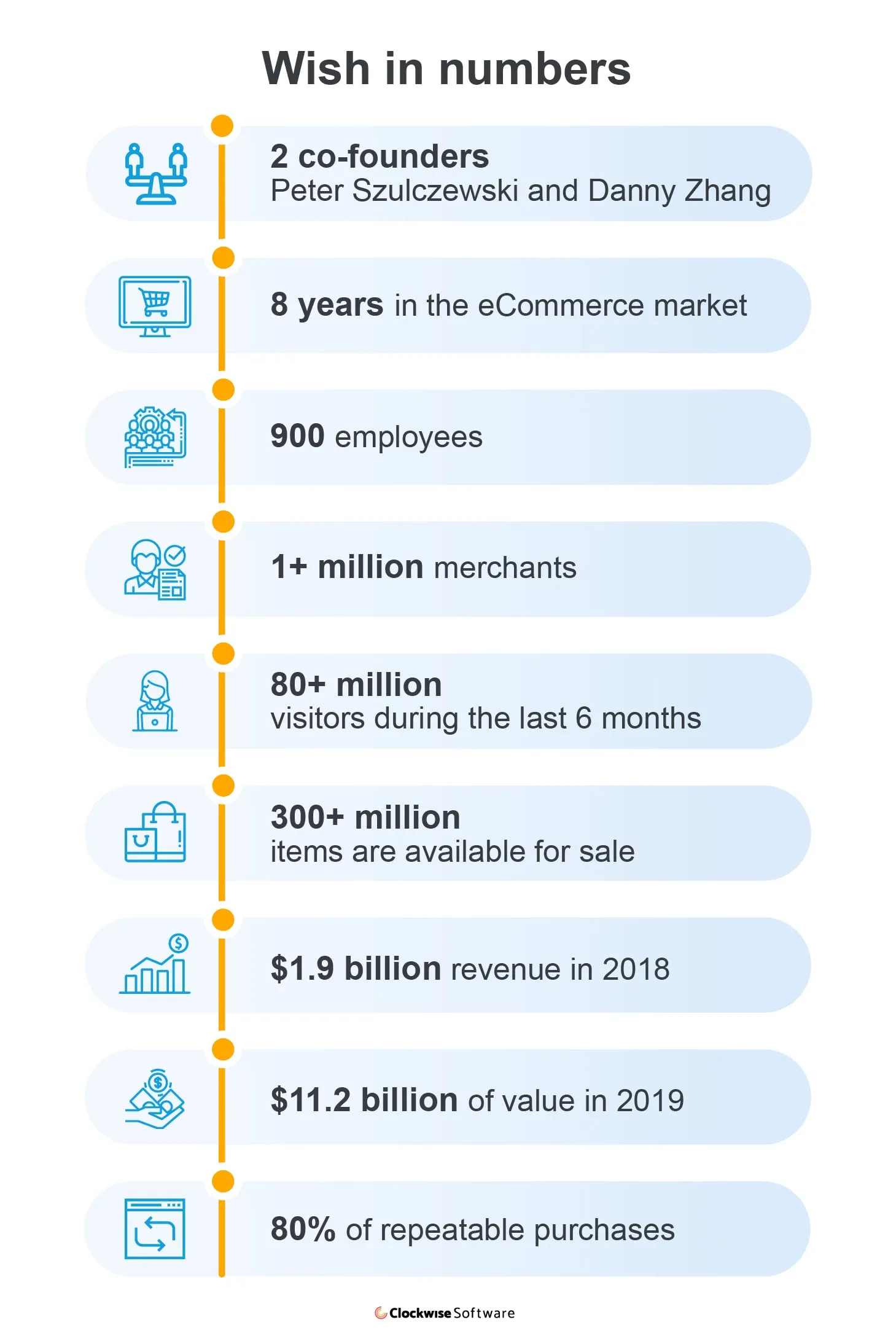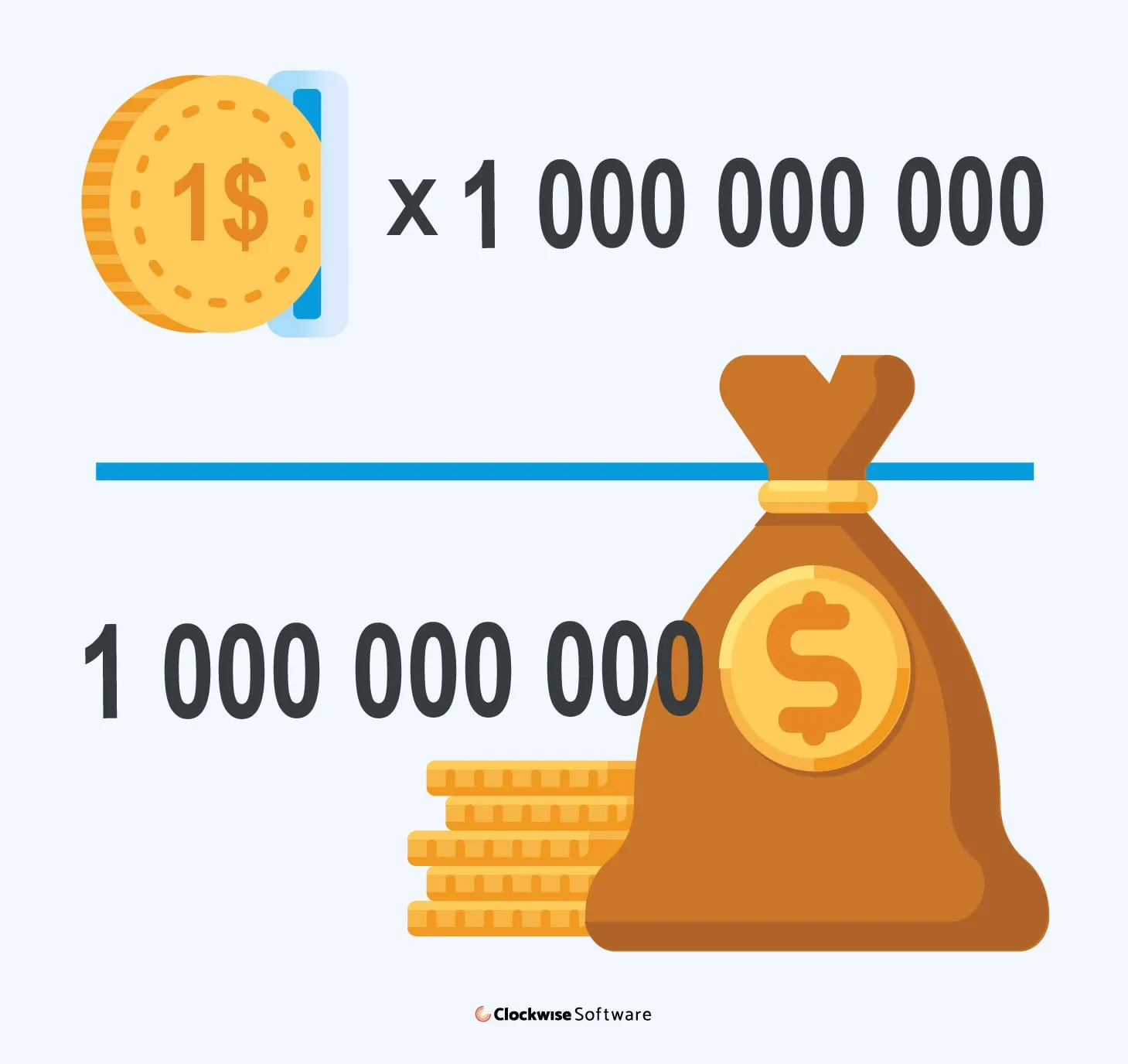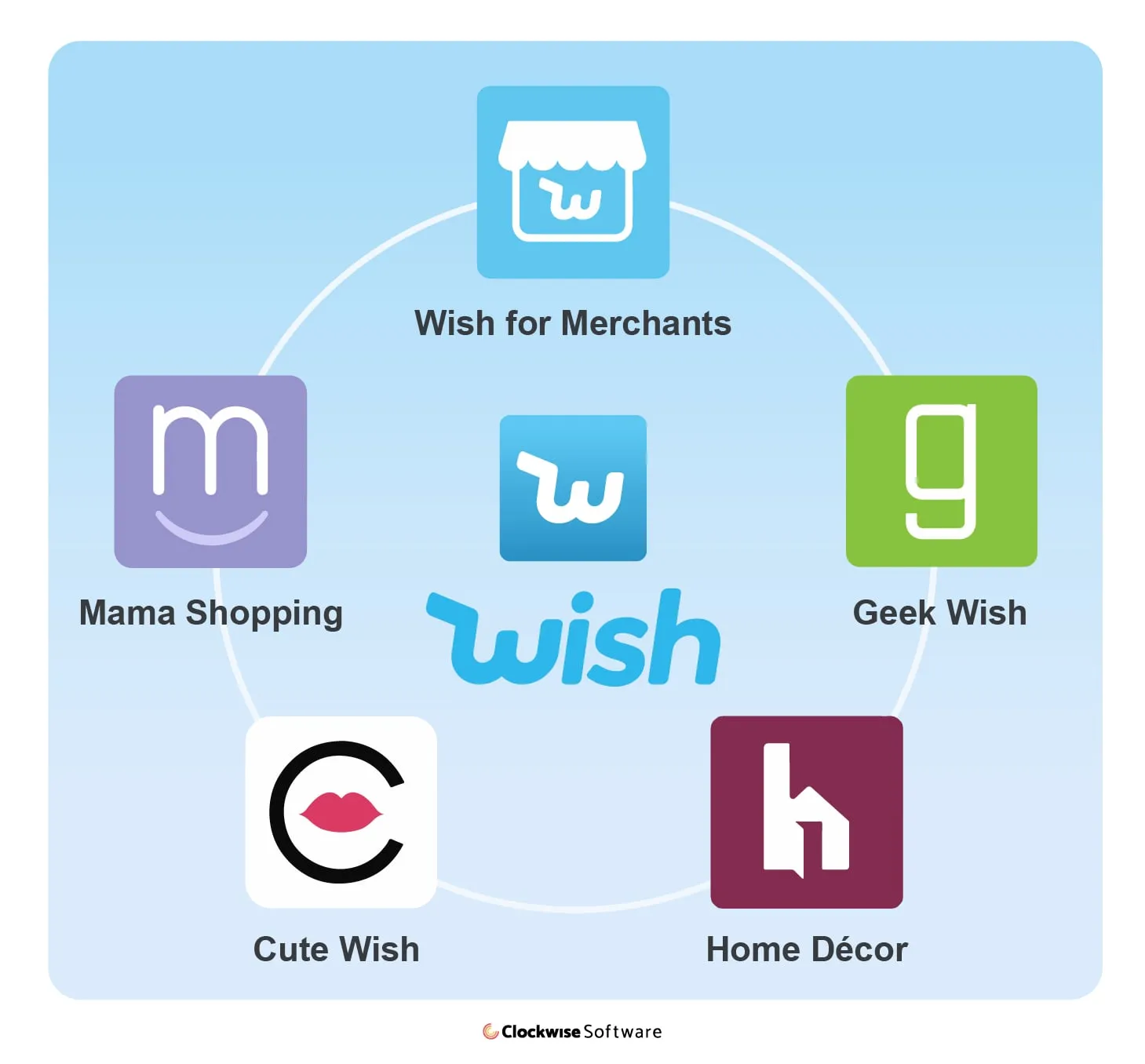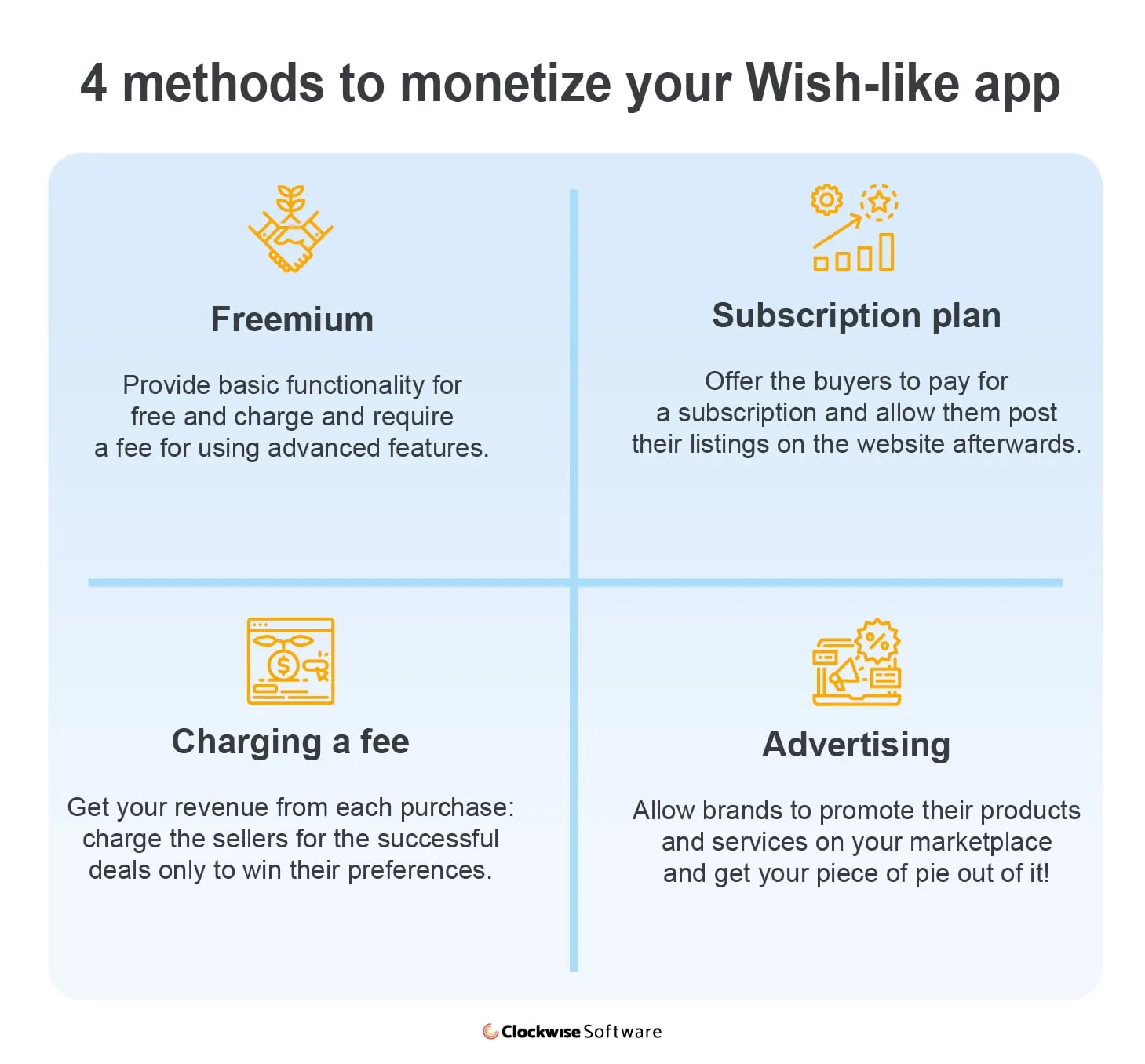What we do
Services
Experts in
What would you do if someone offered you $10 billion for your software product? What would you do if world-known e-commerce leaders wanted to buy your idea or your product? Would you sell it and buy a villa on Cote d'Azur? Or would this offer inspire you to reach even better results and earn more than $10 billion? Would you have enough confidence to reject a proposal like this?
Rumour has it, Peter Szulczewski, one of the Wish e-commerce marketplace founders, said no when Jeff Bezos offered a fabulously huge amount of money for his app. Although non-disclosure agreements didn’t let us find out the exact sum of the offer, the facts are still surprising: a young e-commerce business rejected to join the Amazon corporation! What courage, what the ambitions!
Nowadays, Wish marketplace blooms and blossoms. It is one of the most downloaded shopping apps worldwide, and its popularity keeps rising. Interested in its success and viability, we have decided to investigate its history and spicy details as well as answer a noteworthy question: how to develop an online marketplace like Wish? How to avoid its mistakes and launch an even better solution?
Make yourself comfortable, and get ready for a comprehensive explanation, important details and valuable guide on Wish-like marketplace development.
Some of our readers may haven’t even heard of an app like Wish. It is a sort of e-commerce platform and app: here, you can find tons of different entertaining, useful (and sometimes, low quality) products. In spite of its specifics and even customer complaints, it has found its target audience and reached the billion-dollar success.
The key features of Wish goods are their prices: they are very low here. The reasons may be different, but mostly, low prices are caused by:
To warm up your interest, we collected some of the striking facts about Wish marketplace:

There are more than 80% of the repeatable purchases on a platform. Let’s admit: this is the result that thousands of e-commerce businesses worldwide pursue.
Much can be told about Wish’s extraordinarily cheap prices and powerful advertising. But along with that, Wish should have employed some more tactics and use other approaches to attract so many customers to its pages. We have thought about this and dived into the marketplace’s history to reveal the truth. This is what we are ready to share with you:
One of the company’s founders has experienced Poland’s communism in the 1980s. During his childhood, things like products’ deficit were common. After the emigration to Canada, Szulczewski still was looking at the traditional commerce in his own way. Thus, the co-founder himself says that he planned to make a Wish marketplace for ordinary Americans who live from salary to salary and often prefer cheap products instead of trendy ones.
Both Wish co-founders have powerful IT engineering skills. They studied together in college and trained their skills in companies like Google and Yellow Pages. Thus, when the idea to start own businesses appeared, they both were skilled specialists already.
Wish began its path to success from an MVP - it was a simple platform highlighting popular products. Wish never owned or sold them; people could just add the items to their wish lists. After that, the platform sent ads about an opportunity to sell products to a ready-made customer base to Amazon merchants. In fact, everything a platform did was bringing together sellers and customers. Years went by, and this strategy turned out to be successful. Later, Wish turned into a Marketplace where one can find everything and buy it for the best price.
Wish is free to download; Wish is free to use. So how does Wish make money? The founders make money on a volume of sold products. Extremely low prices, active advertising and a variety of products appeal to customers and make them buy more and more. A 1-dollar difference between the manufacturer’s price and website’s price turns in billion-dollars income if a billion products are sold.

Each of the below-mentioned apps augments the functionality of core Wish shopping app. These apps are closely related; however, they are devoted to different topics and cater to the needs of a particular target audience in a better way.
On Wish website or via a mobile app itself, customers can buy everything from a high-tech gadget to a lady’s purse. Besides, there are 5 more handy programming solutions:

A few lines above, we’ve mentioned the Wish app for buyers. Here, we mean another sort of app. This is an admin panel for merchants they use to trade successfully. Wish application for merchants contains numerous tools and features that make online sales fast, simple and convenient.
This app focuses on selling devices only. In its catalog, laptops, smartwatches, tablets, etc are available for purchase.
Guess what one can buy here? Yeah, you’re right. Home accessories and interior details are in Home Décor app’s assortment.
This is a girlish app. Users can find makeup products and cosmetics, accessories, clothing and similar products here.
Here, merchants present their baby goods for sale. Assortment includes toys, accessories, child-care products, clothes etc.
The fragmentation was constructed to help a customer find exactly what he or she needs.
However, along with the searched products, a customer always has access to some extra categories so the migration between apps and products is quite seamless.
There are many great and useful things we can learn from Wish. To prevail over it and other similar solutions, you should be aware of its disadvantages and things people hate about Wish:

Some of the former customers say that Wish is “just a scam”. Why? That’s all because of the low quality of Chinese products. Gloves that turn your palms blue, power banks that break down the next day they’ve been delivered, earphones that die after the first song on your morning run – this all can be told about Wish products.
What can we learn from it?
Good reputation requires work with recognizable brands and keep an eye on customers’ reviews. Now, Szczulkewski admires that quality control is a huge problem, and Wish tries to improve it. However, the damage is done: many customers will never come back to this marketplace. To make your app like Wish, pay attention to products’ quality.
We investigated apps’ reviews on Play Market. According to some customers’ opinions, Wish store for Merchants has serious troubles with login. No doubts, users are the best testers. However, a company’s engineers should do their work well, too.
What can we learn from it?
Product quality control is significant; app quality assurance is vital. In order to prove you’re better than any similar e-commerce company, you should demonstrate the impeccable quality and react to customers’ complaints immediately.
They say Wish specialists not only fail to provide high-level quality but also fail to react to requests. It is really hard to handle issues when manufacturers are based thousands of miles away from customers. Thus, the customer service team should be well-trained and responsive, not careless.
What can we learn from this?
Listen to your clients. Train your staff. Focus on soft skills development and build your business on customers’ wishes.
There are 2 main problematic use cases:
What can we learn from it?
Brainstorm over your refund policy and study from the best examples. Write about it on your website and let customers know how the entire process looks like. And once again, train your staff to respond to refund-connected troubles quickly.
This chapter requires a special approach. Apps like Wish bring together 3 main parties:
To understand correctly how to build your e-commerce solution, let’s see what features each side of cooperation needs.
| Common Features |
| Live chat so all parties can communicate on a platform in real-time |
| Notifications, reminders, newsletters providing information about recent updates, critical changes, suspicious behaviour, latest news etc. |
| Integration with Google Maps with access to shipping details and order tracking feature. |
| Features for Customers | Features for Sellers | Features for Admin |
| Simple signup to enter the platform in a few clicks | Profile registration and verification | Login with the strong password |
| Profile management features: adding a photo, editing info, etc | Product catalogs to easily add and manage listings | Reports and statistics describing the overall situation in your marketplace |
| Convenient filters to browse product listings | Product advertising and promoting | User management: admin can verify user’s info, view profiles, block them etc. |
| Suggested offers, or products similar to those a customer looks for | Orders section: info about current purchases, payment and shipping details | Product categories management: admin can create new categories, edit the existing ones etc. |
| Good-looking product page with the necessary details provided | Accounting section: let sellers have their entire digital accounting departments | Promotion management and ads posting |
| AR-powered online changing room | Integration with 3rd party services | Reviews and ratings management |
| Wish Lists with opportunity to buy wished products later | Tax calculation feature | |
| Cart containing the items a person wants to buy | Product reviews and ratings | |
| Loyalty programs and exclusive offers | ||
| Several payment options like Pay with Card, PayPal, Stripe etc |

Provide customers with the following opportunities:
Sellers appreciate the following functionality:
The one who manages a marketplace should have access to such functionality:
There are several common features for all involved sides:
Keep in mind that these features are essential. You can add additional ones that depend completely on your platform’s and business’ specifics. However, implementing this basic set of features, you take the first step to online marketplace success.

To build a website like Wish, you have to decide on a monetization model. We have analyzed the easiest way to make money on the e-commerce platform like Wish, and here are some of them:

Providing certain functionality for free, you make customers join your marketplace. Extending their opportunities with more advanced, convenient features, you make them spend money on your app. Keep the “free features - paid features” balance in order not to push users away. Pricing and quality matters, too: demanding much money for questionable features, you harm your own reputation and rapidly lose users’ preference.
If you have a great customer base, you can employ the subscription model. In this case, you:
According to this model, sellers are only allowed to sell products to the customers after they pay for a subscription on your platform. Keep in mind that it is obligatory to have a solid real customer base to use subscriptions.
Quite simply, quite reasonable. You charge sellers for each successful purchase. This model attracts those who don’t sell too much as they don’t have to spend money on rare sales. So if your marketplace isn’t legendary prosperous yet, this may be a good option.
Good old ads move this world forward. In case you’re able to demonstrate impressive metrics, ads may move your business forward, too. To employ this model, the number of visitors should be high enough to make companies pay for ads on your platform.
Here, we would like to highlight the answers to the 3 most popular questions our partners are interested in:

And now let's go into details of each question.
Let have a closer look at the methods available:
You can use special platforms or SaaS products to start fast and easy. Here are some of them:
But we have to warn you: ready-made tools won’t provide you with enough customization and flexibility. They are easy to start with; they provide basic functionality and may help you to validate an idea. But still, they are not powerful enough to build your own prosperous marketplace on their basis. If you invest money in software development, you want to be sure about the results’ quality. And to reach the quality that will bring you revenue, you should opt for custom development.
If you would like your online marketplace to look unique, opt for a tailor-made solution. If you plan to continuously improve your app, add new features and cater to customers’ needs in a better way, choose this option as well.
It may take time. But the results will surprise you. It won’t be cheap, but you will get much higher revenue in return.
If you would like to build a cross-browser solution that also looks great on mobile devices, your team should include:
If you would like to follow the cutting-edge trends, implement Agile for mobile app development and Scrum framework. In this case, you also should hire a Product Owner and a Scrum Master. The HR manager will help you to work with a team. Marketing specialists are needed to promote your fresh new marketplace. So there should be 9+ qualified specialists in your Wish-like app development team.
Here, you have 3 options:
These days, the outsourcing model has proven to be the most reliable, cost-effective and transparent option. Besides, it is much cheaper in comparison with in-house development.
The cost to build a web app from scratch is a complicated question, and the answer depends completely on your product’s specifics. An e-commerce app powered with basic functionality built by a mid-size outsourcing team will cost you between $25.000 and $40.000.
However, you need to remember: own business development and powerful online marketplace require nonstop investments. To move forward, you should continuously work on new functionality development, extend your marketplace’s borders and actively promote the solution. And if you’ll do this right, if you’ll have a qualified team by your side, one day Amazon will contact you with a daydream offer as well.
